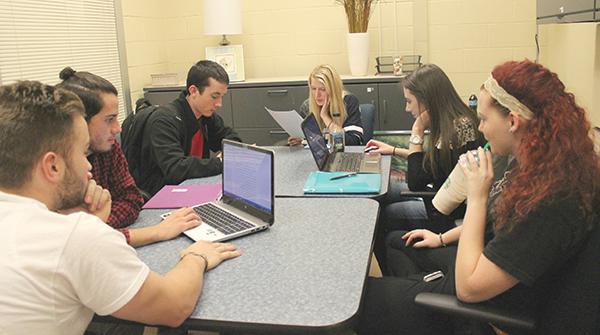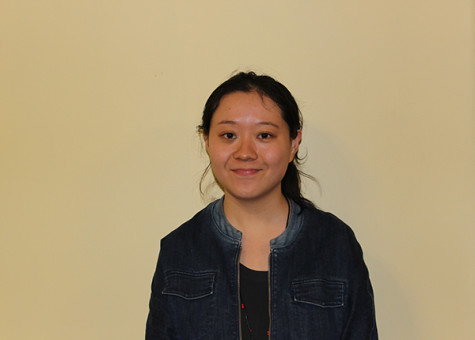Females are mentoring more than males

From left to right sit Vitto Marini, Jacob Williamson-Rea, Dylan Gumbel, Kristin Cafaro, Amanda Eckenrod and Alyshia Sechoka. Tutors Williamson-Rea, Cafaro and Sechoka assist students who attend a drop-in writing tutoring session in the Academic Success Center.
December 16, 2015
When Pitt-Johnstown students request a tutor from the university’s Academic Success Center, they are more likely to find the tutor to be a female than a male.
Among the 109 tutors the center has this semester, 62 percent are females and 37 percent are males, according to Kara Borsa, the center’s tutoring coordinator and an academic counselor.
Females’ numbers outweighing males’ seems to be a growing trend over the past few years for the center’s tutors.
Female tutors outnumbered males in the 2014 and 2015 fall semesters, as the center’s numbers show.
There were six percent more female tutors than male tutors in fall 2013. This number rose to 21 percent in fall 2014. It then increased by 4 percent this semester.
Borsa said comparing the same semesters’ numbers in different years is more accurate than different semesters’ in the same year.
These numbers include drop-in tutors, interdisciplinary studies leaders and one-on-one tutors, Borsa said.
Interdisciplinary studies are the center’s program in which these leaders assist students with undeclared majors in their studies, according to Borsa.
The same trend is also viable in the number of Mentors for Academic and Personal Success.
Although the total number of fall semesters’ mentors has decreased from 23 in 2014 to 18 in 2015, female mentors’ numbers have remained the same at 14. The number of males has decreased from nine to four.
There are specific grade requirements for a student to become a tutor or a mentor at the center; for example, a mathematics drop-in tutor has to have at least a B+ in Calculus 2, Borsa said.
She said one-on-one tutors have flexible working hours for two hours maximum per week with one tutee, and they can have as many as 10 tutees each week.
Drop-in tutors, however, have fixed work schedules and need to meet a designated faculty member in their academic discipline once every week for updates on the faculty’s teaching progress in class.
Pitt-Johnstown students’ male-to-female ratio does not seem to account for these trends because there are more males than females among the students.
According to collegefactual.com, males take up 54.6 percent of students at Pitt-Johnstown, outweighing females’ number by 9.2 percentage points.
It is against the national trend that shows there are more females than males in college students’ demographics.
Colleges’ national average of male-to-female ratio is 40-to-60, which shows that female college students’ number outweigh males’ by 20 percentage points nationwide, according to the website.
Nationally, there also is to be more females holding associate degrees or above in 2015, according to projected numbers on the Digest of Education Statistics in 2012.
Males receiving bachelor’s degrees were outnumbering females until 1982, when females holding bachelor’s degrees outnumbered males by 0.3 percent.
The projected number was to rise to 6.8 percent in 2015, according to the Digest of Education Statistics in 2012.
Whether there is a correlation between Pitt-Johnstown students’ academic performance and their gender is unclear.
Janet Grady, vice president of Academic Affairs, said Dec. 4 that the university had not tracked gender distribution for the students on each year’s dean’s list.
“Gender is not a typical variable that schools use to track student performance, unless there would be a specific reason to do that,” she said.
There typically are hundreds of names on each semester’s dean’s list at Pitt-Johnstown, according to some of these lists on the university’s website.
Paul Newman, assistant vice president of Academic Affairs, said that not having gender-related information is also the case for students on probation or suspension.
“We do not store our data in a way that is sortable by gender,” he said.
He said it is impossible to identify these students’ gender by going through their first name because many are not gender-specific.
He also said Thursday that he was too busy to investigate these students’ gender.
“I’d have to go through the lists and check each name, and I just do not have the time to do that at this point in the semester.”

